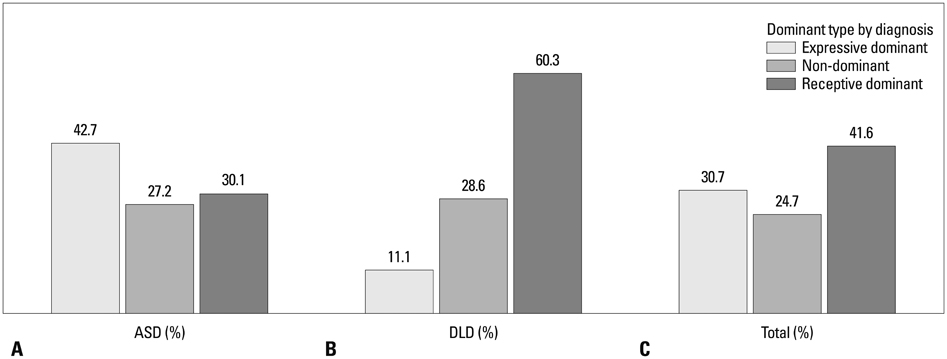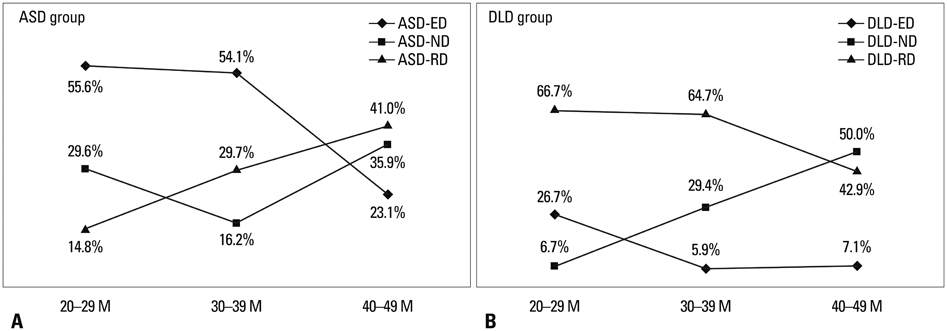Yonsei Med J.
2014 Nov;55(6):1721-1728. 10.3349/ymj.2014.55.6.1721.
A Comparison of Receptive-Expressive Language Profiles between Toddlers with Autism Spectrum Disorder and Developmental Language Delay
- Affiliations
-
- 1Division of Child and Adolescent Psychiatry, Department of Psychiatry and Institute of Behavioral Science in Medicine, Yonsei University College of Medicine, Seoul, Korea. kacheon@yuhs.ac
- 2Department of Communication Disorder, Ewha Woman's University, Seoul, Korea.
- 3Division of Child and Adolescent Psychiatry, Department of Psychiatry, Konyang University College of Medicine, Daejeon, Korea.
- KMID: 2070223
- DOI: http://doi.org/10.3349/ymj.2014.55.6.1721
Abstract
- PURPOSE
It is well known that expressive language impairment is commonly less severe than receptive language impairment in children with autism spectrum disorder (ASD). However, this result is based on experiments in Western countries with Western language scales. This study tries to find whether the result above is applicable for toddlers in a non-Western country; more specifically, in Korea with non-Western language scales.
MATERIALS AND METHODS
The participants were 166 toddlers aged between 20 months and 50 months who visited the clinic from December 2010 to January 2013. The number of toddlers diagnosed as ASD and developmental language delay (DLD) was 103 and 63, respectively. Language development level was assessed using Sequenced Language Scale for Infants (SELSI), a Korean language scale. Using SELSI, each group was divided into 3 sub-groups. Moreover, the group difference by age was observed by dividing them into three age groups. Chi-square test and linear-by-linear association was used for analysis.
RESULTS
Receptive language ability of the DLD group was superior to that of the ASD group in all age groups. However, expressive language ability in both groups showed no difference in all age groups. A greater proportion of expressive dominant type was found in ASD. The 20-29 months group in ASD showed the largest proportion of expressive language dominant type in the three age groups, suggesting that the younger the ASD toddler is, the more severe the receptive language impairment is.
CONCLUSION
These findings suggest that receptive-expressive language characteristics in ASD at earlier age could be useful in the early detection of ASD.
MeSH Terms
Figure
Cited by 2 articles
-
Abnormal Brain Activity in Social Reward Learning in Children with Autism Spectrum Disorder: An fMRI Study
Uk-Su Choi, Sun-Young Kim, Hyeon Jeong Sim, Seo-Young Lee, Sung-Yeon Park, Joon-Sup Jeong, Kyeong In Seol, Hyo-Woon Yoon, Kyungun Jhung, Jee-In Park, Keun-Ah Cheon
Yonsei Med J. 2015;56(3):705-711. doi: 10.3349/ymj.2015.56.3.705.Association Between the Language Development and Behavioral-Emotional Problems in Children With Ankyloglossia
Jong Hwan Lee, Su Il Kim, Seul Ah Lee, Tae Hoon Kim, Young-Gyu Eun, Young Chan Lee
Korean J Otorhinolaryngol-Head Neck Surg. 2023;66(7):462-468. doi: 10.3342/kjorl-hns.2022.00822.
Reference
-
1. Amer Psychiatric Pub Incorporated. Diagnostic and Statistical Manual of Mental Disorders. 5th ed. Arlington: Amer Psychiatric Pub Incorporated;2013.2. Baranek GT. Autism during infancy: a retrospective video analysis of sensory-motor and social behaviors at 9-12 months of age. J Autism Dev Disord. 1999; 29:213–224.3. De Giacomo A, Fombonne E. Parental recognition of developmental abnormalities in autism. Eur Child Adolesc Psychiatry. 1998; 7:131–136.
Article4. Maestro S, Muratori F, Barbieri F, Casella C, Cattaneo V, Cavallaro MC, et al. Early behavioral development in autistic children: the first 2 years of life through home movies. Psychopathology. 2001; 34:147–152.
Article5. Clifford SM, Dissanayake C. The early development of joint attention in infants with autistic disorder using home video observations and parental interview. J Autism Dev Disord. 2008; 38:791–805.
Article6. Maestro S, Muratori F, Cesari A, Cavallaro MC, Paziente A, Pecini C, et al. Course of autism signs in the first year of life. Psychopathology. 2005; 38:26–31.
Article7. Zwaigenbaum L, Bryson S, Rogers T, Roberts W, Brian J, Szatmari P. Behavioral manifestations of autism in the first year of life. Int J Dev Neurosci. 2005; 23:143–152.
Article8. Iverson JM, Wozniak RH. Variation in vocal-motor development in infant siblings of children with autism. J Autism Dev Disord. 2007; 37:158–170.
Article9. Osterling JA, Dawson G, Munson JA. Early recognition of 1-year-old infants with autism spectrum disorder versus mental retardation. Dev Psychopathol. 2002; 14:239–251.
Article10. Watson LR, Crais ER, Baranek GT, Dykstra JR, Wilson KP. Communicative gesture use in infants with and without autism: a retrospective home video study. Am J Speech Lang Pathol. 2013; 22:25–39.
Article11. Clifford S, Young R, Williamson P. Assessing the early characteristics of autistic disorder using video analysis. J Autism Dev Disord. 2007; 37:301–313.
Article12. Zwaigenbaum L, Bryson S, Garon N. Early identification of autism spectrum disorders. Behav Brain Res. 2013; 251:133–146.
Article13. Tager-Flusberg H, Caronna E. Language disorders: autism and other pervasive developmental disorders. Pediatr Clin North Am. 2007; 54:469–481.
Article14. Loukusa S, Leinonen E, Kuusikko S, Jussila K, Mattila ML, Ryder N, et al. Use of context in pragmatic language comprehension by children with Asperger syndrome or high-functioning autism. J Autism Dev Disord. 2007; 37:1049–1059.
Article15. Venter A, Lord C, Schopler E. A follow-up study of high-functioning autistic children. J Child Psychol Psychiatry. 1992; 33:489–507.
Article16. Szatmari P, Bryson S, Duku E, Vaccarella L, Zwaigenbaum L, Bennett T, et al. Similar developmental trajectories in autism and Asperger syndrome: from early childhood to adolescence. J Child Psychol Psychiatry. 2009; 50:1459–1467.
Article17. Fenson L, Dale PS, Reznick JS, Bates E, Thal DJ, Pethick SJ. Variability in early communicative development. Monogr Soc Res Child Dev. 1994; 59:1–173.
Article18. Kjelgaard MM, Tager-Flusberg H. An Investigation of Language Impairment in Autism: Implications for Genetic Subgroups. Lang Cogn Process. 2001; 16:287–308.
Article19. Luyster RJ, Kadlec MB, Carter A, Tager-Flusberg H. Language assessment and development in toddlers with autism spectrum disorders. J Autism Dev Disord. 2008; 38:1426–1438.
Article20. Rutter M, Mawhood L, Howlin P. Language delay and social development. In : Fletcher P, Hall DMB, Auger E, editors. Specific speech and language disorders in children: correlates, characteristics, and outcomes. San Diego, CA: Singular Pub. Group;1992. p. 63–78.21. Amaral DG, Dawson G, Geschwind DH. Autism Spectrum Disorders. New York: Oxford Univ. Press.;2011.22. Kim YT. Content and reliability analyses of the Sequenced Language Scale for Infants (SELSI). Commun Sci Dis. 2002; 7:1–23.23. Ellis Weismer S, Lord C, Esler A. Early language patterns of toddlers on the autism spectrum compared to toddlers with developmental delay. J Autism Dev Disord. 2010; 40:1259–1273.
Article24. Tager-Flusberg H, Paul R, Lord CE. Language and communication in autism. In : Volkmar FR, editor. Handbook of autism and pervasive developmental disorders. 3rd ed. Hoboken, NJ: John Wiley & Sons;2005. p. 335–364.25. Eaves LC, Ho HH. The very early identification of autism: outcome to age 4 1/2-5. J Autism Dev Disord. 2004; 34:367–378.
Article26. Sharp HM, Hillenbrand K. Speech and language development and disorders in children. Pediatr Clin North Am. 2008; 55:1159–1173.
Article27. Hudry K, Leadbitter K, Temple K, Slonims V, McConachie H, Aldred C, et al. Preschoolers with autism show greater impairment in receptive compared with expressive language abilities. Int J Lang Commun Disord. 2010; 45:681–690.
Article28. Mitchell S, Brian J, Zwaigenbaum L, Roberts W, Szatmari P, Smith I, et al. Early language and communication development of infants later diagnosed with autism spectrum disorder. J Dev Behav Pediatr. 2006; 27:2 Suppl. S69–S78.
Article29. Fay WH, Coleman RO. A human sound transducer/reproducer: temporal capabilities of a profoundly echolalic child. Brain Lang. 1977; 4:396–402.
Article30. Grossi D, Marcone R, Cinquegrana T, Gallucci M. On the differential nature of induced and incidental echolalia in autism. J Intellect Disabil Res. 2013; 57:903–912.
Article31. Boddaert N, Belin P, Chabane N, Poline JB, Barthélémy C, Mouren-Simeoni MC, et al. Perception of complex sounds: abnormal pattern of cortical activation in autism. Am J Psychiatry. 2003; 160:2057–2060.
Article32. Boddaert N, Chabane N, Belin P, Bourgeois M, Royer V, Barthelemy C, et al. Perception of complex sounds in autism: abnormal auditory cortical processing in children. Am J Psychiatry. 2004; 161:2117–2120.
Article
- Full Text Links
- Actions
-
Cited
- CITED
-
- Close
- Share
- Similar articles
-
- Correlation of Language Assessment Batteries of Toddlers With Developmental Language Delay
- Developmental Delay of Language in Cerebral Palsy Children
- Relationship of Language, Intelligent and Social Quotients in Children with Speech and Language Disorder
- The Comparison of M-B CDI-K Short Form and K-ASQ as Screening Test for Language Development
- Differences of Obstetric Complications and Clinical Characteristics between Autism Spectrum Disorder and Intellectual Disability




